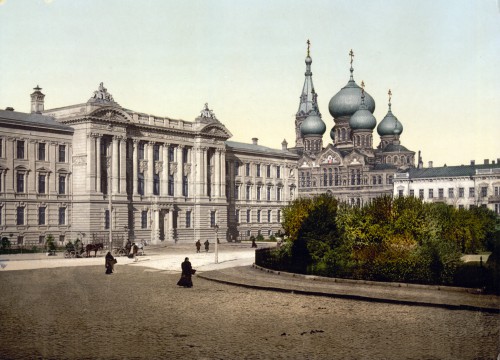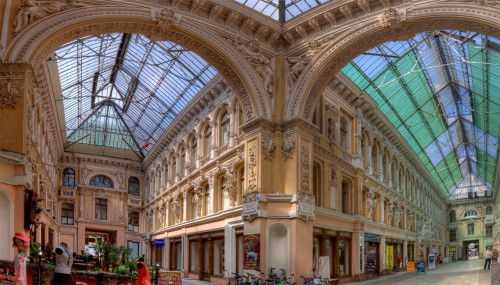mercredi, 30 avril 2014
What Makes Odessa Rise in Protest?

What Makes Odessa Rise in Protest?
|
Ex: http://www.strategic-culture.org |
|
The people of Donetsk and Lugansk regions captured administrative buildings, got hold of arms and declared independence from Ukraine. They are fighting the Kiev regime. The world attention is focused on what is happening there. But there are other hotbeds in Ukraine. Unlike Donbass, the region of Odessa has no border with Russia and it’s not a homeport for the Russian Black Sea Fleet. But local people hit the streets with Russian flags and express their will to get separated from Ukraine. In ancient times there region was populated by Greeks, the populated areas were mainly concentrated along the rivers Dnieper, South Buh and Dniester, which run directly into the Black Sea. There were other colonies: the ancient Greek cities of Tyras, Olbia and Nikonia trading with Scythian and Cimmerians. The successive rulers in the Middle Ages included Nogai Ulus of Golden Horde and many others.
During a Russia-Ottoman Empire war a small Russian force headed by Spanish Grand Don José de Ribas y Boyonswas captured the fortress to let it be a forlorn place for four years more. Then Ribas was assigned to build a city and a home port for a squadron of galleys he was to command. It boosted trade. François Sainte de Wollant, an engineer from Brabant, was responsible for the construction. De Ribas was the first mayor of Odessa. The city really thrived under Armand-Emmanuel du Plessis, Duke of Richelieu, and a successor of the legendary cardinal of France. During 12 years of his rule the population grew four times and the city became the heart of the Novorossiysk region. A theatre, a printing-house and an institute were built. Later Richelieu returned to France to hold the positions of Foreign Minister and prime-Minister (twice). The first city settlers were Greeks, Italians, Albanians, and Armenians. By the end of XIX century Russians accounted for 49% of the population but one could see people of all nationalities and from all the countries of the world. By 1912 the city’s population increased to half a million, it became the fourth largest city of the Russian Empire after Moscow, Saint-Petersburg and Warsaw. The 1917 revolution made it change hands. The cosmopolitan city dwellers were indifferent to the Whites, Reds and British-French occupation force. At that they always treated with disrespect the Ukrainian authorities headed by Michael Grushevsky (Mykhailo Hrushevsky), Symon Petliura and Pavel (Pavlo) Skoropadskyi. They did not believe that those people were able to create a viable state. They were treated as occupants by the Russian speaking population of Odessa. By the beginning of WWII the city was populated by Russians (39, 2 %), Jews (36, 9 %), Ukrainians (17, 7 %) and Poles (2, 4 %). Partly the population left the city in front of the offensive by German and Romanian troops, 250 thousand remain surrounded by the enemy. After the Red Army left the city, they faced the hardships of life under occupation. 80-90% of those who remained were Jews, Almost all of them died in the hands of Nazi, Romanian soldiers and Ukrainian nationalists. Ghettos and concentration camps left little chance to remain alive for the victims of Holocaust. In the 1980s Jews got an opportunity to leave for Israel. Then the Ukraine’s independence was accompanied by abrupt fall in living standards. It drastically reduced the Jewish population. No matter that, the Jewish community remained to be the most numerous and influential. The coup in Kiev tool place in February 2014 had little support among city dwellers. The Kiev rulers are mainly represented by advocates of Ukrainian integral nationalism that appeared in the 1920-30s as a mixture of Italian fascism and German national-socialism with specific Ukrainian features. The Ukraine’s interim government is represented by odious personalities openly advocating Nazi ideology. For instance, Andriy Parubiy, the head of National Security and Defense Council of Ukraine, who tried to register a Nazi political party at the beginning of the 1990s. Back then the Justice Ministry refused to do it because the word «national-socialism» was included in the name. Parubiy changed the order of words to head the Social-Nationalist organization. The program remained filled with xenophobia and racism. The party later became Svoboda. Today it is headed by well-known anti-Semite and xenophobe Oleh Tyahnybok. Svoboda boasts a few members in the Yatsenyuk government. Pravy Sector was the main driving force behind the coup. It’s a conglomerate of Nazi oriented groups with Trizub as the leader. It stands for the purity of white race and calls for Hitler times practiced purges. Pravy Sector also comprises the «Patriots of Ukraine» created by Parubiy as a Social-Nationalist youth organization. The «Patriots» served as a basis for establishing the Social-Nationalist Assembly in 2008. The first thing it did was the announcement of war to be waged against other races, the plans to make Ukraine a nuclear state and global domination as a goal to be reached. According to the Assembly’s program, national minorities are to be either assimilated or exiled. Many people who live in Odessa lost their next of kin during the days of Holocaust; the prospect of being ruled by the people making part of the Kiev government is unacceptable for them… Ukrainian policemen treated Jews no better than Germans; they advocated the nationalist ideology which practically became state ideology of contemporary Ukraine. The Maidan slogan «Long Live Ukraine. Glory to the Heroes!» is nothing else but the password of the Organization of Ukrainian Nationalists named after Stepan Bandera, an agent of Abwehr who took an oath of loyalty to Hitler. He and Roman Shukhevych, captain of Wehrmacht, deputy commander of punitive force are recognized as heroes. No way could this government be acceptable for the people who live in Odessa. They will always oppose it. Trying to see a hand of Moscow here is useless. The reason for people’s sentiments lies in the history of the city.
|
00:05 Publié dans Actualité, Affaires européennes, Géopolitique | Lien permanent | Commentaires (0) | Tags : odessa, politique internationale, ukraine, russie, crimée, europe, affaires européennes, mer noire, espace pontique |  |
|  del.icio.us |
del.icio.us |  |
|  Digg |
Digg | ![]() Facebook
Facebook



 During the reign of Khan Haci I Giray of Crimea (1441–1466), the Khanate was endangered by the Golden Horde and the Ottoman Empire and, in search of allies, the khan agreed to cede the area to Lithuania. The site of present-day Odessa was then a town known as Khadjibey (named for Hacı I Giray, also spelled Kocibey in English). It was part of the Dykra region. However, most of the rest of the area remained largely uninhabited in this period. In 1765 the Ottomans rebuilt a fortress at Khadjibey (Hocabey), which was named Yeni Dünya. Hocabey was a sanjak centre of Silistre Province.
During the reign of Khan Haci I Giray of Crimea (1441–1466), the Khanate was endangered by the Golden Horde and the Ottoman Empire and, in search of allies, the khan agreed to cede the area to Lithuania. The site of present-day Odessa was then a town known as Khadjibey (named for Hacı I Giray, also spelled Kocibey in English). It was part of the Dykra region. However, most of the rest of the area remained largely uninhabited in this period. In 1765 the Ottomans rebuilt a fortress at Khadjibey (Hocabey), which was named Yeni Dünya. Hocabey was a sanjak centre of Silistre Province.
Les commentaires sont fermés.